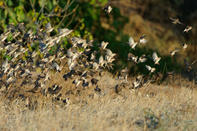
Name
Red-billed quelea (Quelea quelea)Appearance
The red-billed quelea is a sparrow-sized bird around 12 cm in length, with a cone, seed eater shaped, bill. The red-billed quelea is a bird with various colourings. The male red-billed quelea in breeding colours has a face mask that varies in colour from black to white.
The mask is surrounded by a yellow to pink band. The underparts are light brown or whitish in colour. The upperparts have alternating light and dark brown stripes. The tail and upper wings are dark brown, with greenish to yellow flight feathers. The male's bill is bright red and legs are orange.
The male resembles the female outside of breeding season. The female red-billed quelea has a grey to brown head, a whitish chin and throat and some birds have a slight stripe above the eye.
The female has a pink bill outside of the breeding season. During the breeding season, the bill turns yellow to orange and a distinctive orange eye ring is present.
Diet
The red-billed quelea feeds mainly on grass seeds, but will eat insects. They also feed on crops of millet, oats, wheat and sorghum.Red-billed Quelea Breeding
The red-billed quelea is monogamous and colonial. They breed in huge colonies. The nest is a small oval ball of grass, with an entrance on the side. The female will typically lay 3 eggs, which are incubated by both the male and the female for around 11 days. The chicks are fed by both parents and are independent at around 19 days.Behaviour
The red-billed quelea is possibly the most abundant bird species on earth, with their nickname throughout Africa, as the “feathered locust”. The red-billed quelea is a pest to nearly all grain farmers and has become a major threat to both subsistence and mechanised crop production.
There are millions of queleas killed by governmental and commercial pest control operations each year, but the birds remain very abundant. The red-billed quelea feeds in huge flocks, up to one million individuals at a time, with the birds at the rear running short of food and then flying over the flock to be in front, where the fresh food is available.
This creates an image of a rolling cloud or wave. The male red-billed quelea builds the nest, which takes 2 to 3 days to build. The nest is built out of fresh green grass. Up to 6000 nests have been recorded in a single tree.